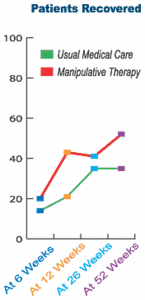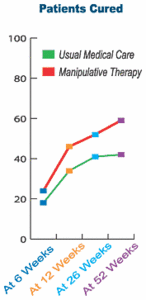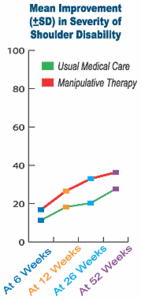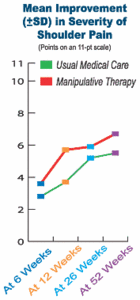Usual medical care (control group) included "information, advice, and therapy." During the first two weeks of care, patients in the control group "were given information about the nature and course of shoulder symptoms, along with advice on daily use of the affected shoulder" with prescriptions for "oral analgesics or nonsteroidal anti-inflammatory drugs (NSAIDs) if necessary." Control group patients who did improve could receive another two weeks of analgesics or NSAIDs; if this approach was ineffective, they could be given "up to 3 corticosteroid injections." If improvement remained insufficient two weeks after injections were administered, the injections could be repeated, or patients could be referred for physiotherapy consisting of shoulder exercises, massage, and physical applications.
Patients in the intervention group received usual care and manipulative therapy that included specific manipulations (low-amplitude, high-velocity thrust techniques) and specific mobilizations (high-amplitude, low-velocity thrust techniques) "to improve overall joint function and decrease any restrictions in movement at single or multiple segmental levels in the cervical spine and upper thoracic spine and adjacent ribs." (emphasis added) This is an important point, as this study provides evidence that by utilizing spinal manipulation to address shoulder pain and dysfunction, problems in the shoulder (and other extremities) can be addressed through manipulation of the spine.
A maximum of six treatment sessions could be given over a 12-week period. While physiotherapists provided the manual therapy, the manipulative techniques used were similar to those commonly performed by doctors of chiropractic.
Almost all of the control patients (92%) "were treated with a wait-and-see policy, 28% were treated with corticosteroid injections, and 27% were referred to a physical therapist for a maximum of 9 treatment sessions." Patients in the manipulative therapy group received similar care, but in addition, they received an average of 3.8 "treatment sessions from a manual therapist."
Data on the patients were collected during and at the end of the treatment period (at six and 12 weeks) and during the follow-up period (at 26 and 52 weeks). At the completion of care (12 weeks), "43% of the intervention group and 21% of the control group reported full recovery." After a full year (52 weeks), "approximately the same difference in recovery rate (17 percentage points) was seen between groups."
The differences in results showed substantial improvement for those patients receiving manipulative therapy. (See graphs below.)
The authors made several important comments regarding their study:
- "We demonstrated that manipulative therapy for the shoulder girdle in addition to usual medical care by a general practitioner accelerated recovery of shoulder symptoms and reduced their severity. These effects were sustained at 52 weeks of follow-up."
- "We believe that general practitioners should include a short physical examination of the shoulder girdle in their structured medical examinations. For patients with shoulder symptoms in whom dysfunction of the cervicothoracic spine and adjacent ribs is found, referral to a manual therapist should be considered."
The authors also point out the fact that this is the first study of its kind:
"To our knowledge, this is the first trial to focus on the effectiveness of adding manipulative therapy for the cervicothoracic spine and the adjacent ribs to usual medical care for treatment of shoulder symptoms."
For doctors of chiropractic, this study is important because it demonstrates the value of chiropractic manipulation for extremities. This is a significant move away from the thinking that manipulation is only focused on spinal ailments. As this study was published in the Annals of Internal Medicine, a prominent medical research journal, these findings kick open the door for research into the value of manipulation for all extremities - an important step toward a greater appreciation of chiropractic in treating the whole person.
Reference
- Bergman GJD, Winters JC, Groenier KH, et al. Manipulative therapy in addition to usual medical care for patients with shoulder dysfunction and pain. Ann Intern Med 2004;141:4320439.
Dynamic Chiropractic editorial staff members research, investigate and write articles for the publication on an ongoing basis. To contact the Editorial Department or submit an article of your own for consideration, email
.









